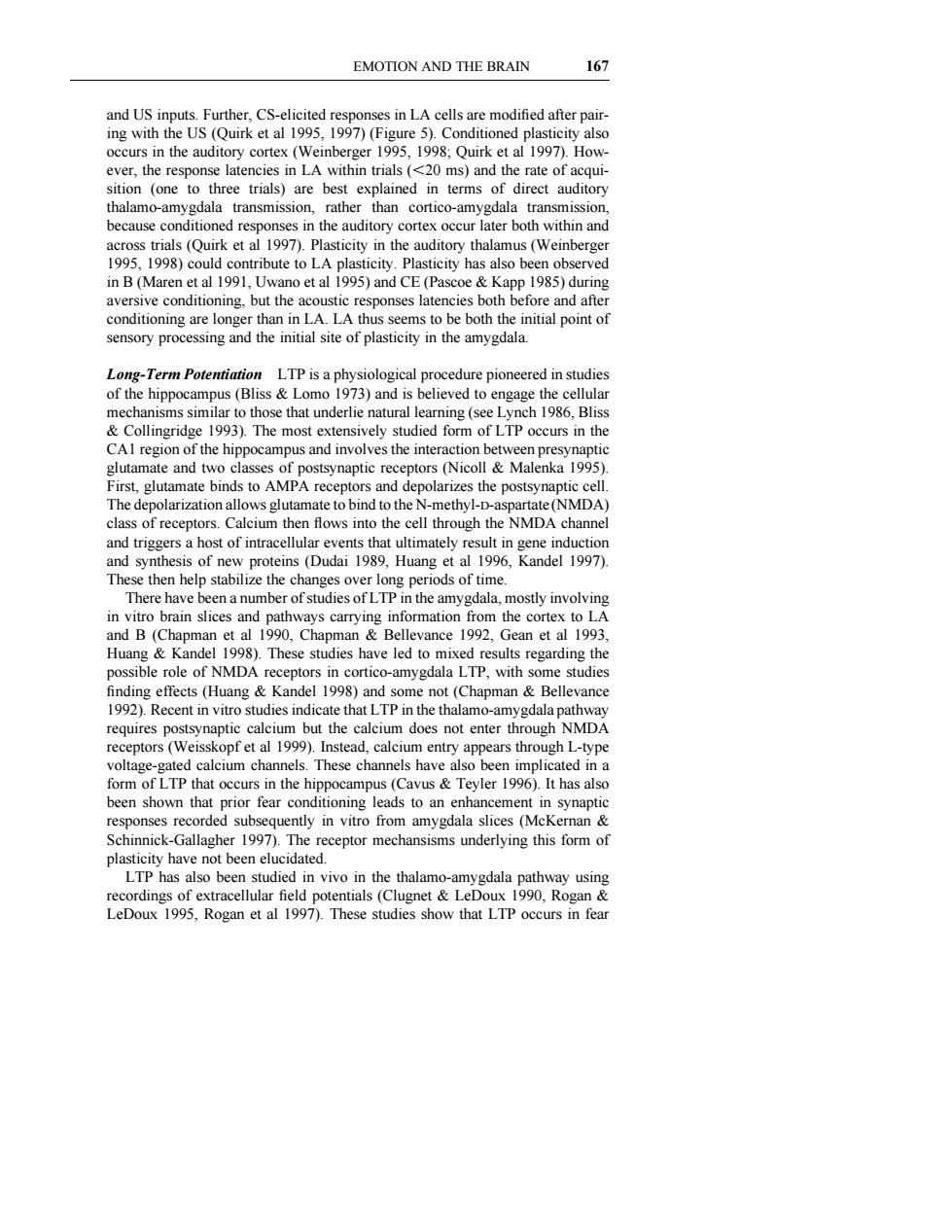正在加载图片...

EMOTION AND THE BRAIN 167 and US inputs.Further,CS-elicited responses in LA cells are modified after pair ing with the US(Quirk et al 1995,1997)(Figure 5).Conditioned plasticity also occurs in the auditory cortex (Weinberger 1995,1998;Quirk et al 1997).How- ever,the response latencies in LA within trials(<20 ms)and the rate of acqui- sition (oe to three trials)are best explained in terms of direct auditory thalamo-amygdala transmission,rather than coric-amygdala transmissio because conditioned responses in the auditory cortex occur later both within and across trials(Quirk et al 1997).Plasticity in the auditory thalamus(Weinberger 1995,1998)could contribute to LA plasticity.Plasticity has also been observed in B(Maren et al 1991,Uwano et al 1995)and CE(Pa coe app1985)dur aversive conditioning,but the acoustic responses latencies both before and after conditioning are longer than in LA.LA thus seems to be both the initial point of sensory processing and the initial site of plasticity in the amygdala Long-Term Potentiation LTP is aphysiological procedure pioneered in studies of the hippocampus(Bliss&Lomo 1973)and is believed to engage the cellular mechanisms similar to those that underlie natural learning(see Lynch 1986,Bliss Collingridge 1993).The most extensively studied form of LTP occurs in the CAl region of the hippoc s and involves the intera tion bet en pr First,glutamate binds to AMPA receptors and depolarizes the postsynaptic cell The depolarization allows glutamate to bind to the N-methyl-D-aspartate(NMDA) class of receptors.Calcium then flows into the cell through the NMDA channel timately induction and synthesis of new proteins(Dudai 1989 Huang et al 199,Kandel 1997). These then help stabilize the changes over long periods of time. There have been a number of studies of LTP in the amygdala,mostly involving in vito brain slices and pathways carrying information from the cortex to LA and B(Cha et Chapma &Bellevance 1992.Ge ean et al 1993. Huang Kandel 1998).These studies have led to mixed results regarding the possible role of NMDA receptors in cortico-amygdala LTP,with some studies finding effects(Huang&Kandel 1998)and some not(Chapman&Bellevance 1992).Recent in ostudies indicat ui calcim but MDA it receptors(Weisskopf et al 1999).Instead,calcium entry appears through L-type voltage-gated calcium channels.These channels have also been implicated in a form of LTP that occurs in the hippocampus(Cavus Teyler 1996).It has also been shown that prio fear co onditioning leads to an in synaptic responses recorded subsequently in vitro from amygdala slices (MeKernan& Schinnick-Gallagher 1997).The receptor mechansisms underlying this form of plasticity have not been elucidated. ITP has also bee studied in vivo in the thalamo-amygdala pathway using recordings of extracellular field potentials(Clugnet&LeDoux 1990,Rogan LeDoux 1995,Rogan et al 1997).These studies show that LTP occurs in fear EMOTION AND THE BRAIN 167 and US inputs. Further, CS-elicited responses in LA cells are modified after pairing with the US (Quirk et al 1995, 1997) (Figure 5). Conditioned plasticity also occurs in the auditory cortex (Weinberger 1995, 1998; Quirk et al 1997). However, the response latencies in LA within trials (,20 ms) and the rate of acquisition (one to three trials) are best explained in terms of direct auditory thalamo-amygdala transmission, rather than cortico-amygdala transmission, because conditioned responses in the auditory cortex occur later both within and across trials (Quirk et al 1997). Plasticity in the auditory thalamus (Weinberger 1995, 1998) could contribute to LA plasticity. Plasticity has also been observed in B (Maren et al 1991, Uwano et al 1995) and CE (Pascoe & Kapp 1985) during aversive conditioning, but the acoustic responses latencies both before and after conditioning are longer than in LA. LA thus seems to be both the initial point of sensory processing and the initial site of plasticity in the amygdala. Long-Term Potentiation LTP is a physiological procedure pioneered in studies of the hippocampus (Bliss & Lomo 1973) and is believed to engage the cellular mechanisms similar to those that underlie natural learning (see Lynch 1986, Bliss & Collingridge 1993). The most extensively studied form of LTP occurs in the CA1 region of the hippocampus and involves the interaction between presynaptic glutamate and two classes of postsynaptic receptors (Nicoll & Malenka 1995). First, glutamate binds to AMPA receptors and depolarizes the postsynaptic cell. The depolarization allows glutamate to bind to the N-methyl-D-aspartate (NMDA) class of receptors. Calcium then flows into the cell through the NMDA channel and triggers a host of intracellular events that ultimately result in gene induction and synthesis of new proteins (Dudai 1989, Huang et al 1996, Kandel 1997). These then help stabilize the changes over long periods of time. There have been a number of studies of LTP in the amygdala, mostly involving in vitro brain slices and pathways carrying information from the cortex to LA and B (Chapman et al 1990, Chapman & Bellevance 1992, Gean et al 1993, Huang & Kandel 1998). These studies have led to mixed results regarding the possible role of NMDA receptors in cortico-amygdala LTP, with some studies finding effects (Huang & Kandel 1998) and some not (Chapman & Bellevance 1992). Recent in vitro studies indicate that LTP in the thalamo-amygdala pathway requires postsynaptic calcium but the calcium does not enter through NMDA receptors (Weisskopf et al 1999). Instead, calcium entry appears through L-type voltage-gated calcium channels. These channels have also been implicated in a form of LTP that occurs in the hippocampus (Cavus & Teyler 1996). It has also been shown that prior fear conditioning leads to an enhancement in synaptic responses recorded subsequently in vitro from amygdala slices (McKernan & Schinnick-Gallagher 1997). The receptor mechansisms underlying this form of plasticity have not been elucidated. LTP has also been studied in vivo in the thalamo-amygdala pathway using recordings of extracellular field potentials (Clugnet & LeDoux 1990, Rogan & LeDoux 1995, Rogan et al 1997). These studies show that LTP occurs in fear